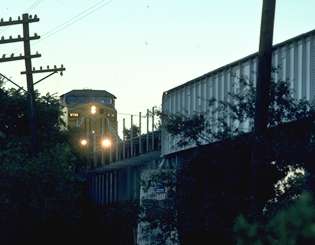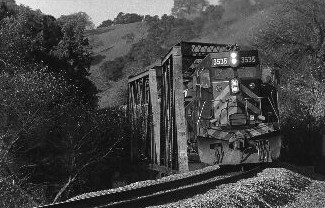| The "Other" Canyon Western Pacific's Niles Canyon Excerpted from The Feather River Route,
by Ken Rattenne When mentioning the term "canyon" in relation to the Western Pacific, the first thought that comes to mind is the deep chasm that formed the railroad's most scenic piece of trackage: the Feather River Canyon. But to exit the San Francisco Bay Area WP ran through another, much shorter canyon. Carved from the coastal hills by Alameda Creek, Niles Canyon stretches eight railroad miles between Fremont (formerly called Niles) and Sunol, a tiny unincorporated burg known mostly for its biker bar and a local cat that was once elected mayor (railfans often extend the boundry of Niles Canyon to just beyond Hearst Siding, including this writer). The tracks follow Alameda Creek then run briefly along the northern side of the narrow Alameda Valley. At Sunol the line makes a sharp left turn to continue through the last vestiges of the canyon. Passing through the posh Castlewood Golf Course at the west end of Pleasanton, the line finally breaks out into the Livermore Valley. Trackage through Niles Canyon was not easy to lay - Southern Pacific had already taken the easy route along the left bank of Alameda Creek more than two decades earlier. This forced WP engineers to bore two tunnels and construct a handsome steel bridge to lay their steel trail through the shadowy defile. A lot of scenery is packed into Niles Canyon: In spite of deep shadows and a rain forest-like atmosphere, it has drawn a steady stream of photographers to record the parade of trains running between Oakland and Stockton on what was once Western Pacific's First Subdivision. Today, the trackage through Niles is still active, but just barely. Since the Union Pacific-Southern Pacific merger UP has moved the majority of their transcontinental traffic to the former SP lines and thus few freights see the depts of Niles Canyon. The one bright spot is the Altamont Commuter Express' daily parade of passenger trains, which can be photographed only during the summer months, and even then only in the late afternoon. |
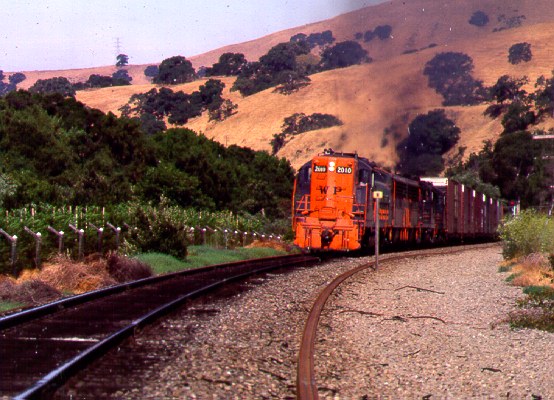
(Ken Rattenne Photo) With
the morning San Jose Manifest in tow, WP GP20 2010 leads a pair of F7As
and two Geeps with a classic First Generation lashup in September of 1982
. The train is passing through the east end of Niles Canyon approaching
the town of Sunol.
|
| HELPER
SERVICE
Or Dog Day In Niles Canyon Though not a regular occurance, there were occasions when WP freights needed a little nudge to get from point A to point B. One such occurance was recorded on a very hot August 7th, 1982, when an underpowered O-WPX was forced to take the siding at Hearst (at the east end of Niles Canyon) when one of it's two pooled 3,000 hp Union Pacific U30C's gave up the ghost near Sunol. After several unsuccessful attempts at restarting the unit, it was decided to double the hill to Altamont Summit where the train could be reassembled for the downhill run to Stockton. So underpowered was this train, that the dispatcher contacted Fremont Yard to see if there was a locomotive available to assist the train in shoving the second (and longest) half to summit. Coming to the rescue that day was long-time WP employee Jack McClure, seen above standing on the catwalk of his trusty steed, WP GP7 706. The 706 was one of two units assigned to Fremont Yard and the only one actually in Fremont Yard1 that day. The unit was part of WP's first order of roadswitchers, having been built in 1950 and sporting a mere 1,500 hp. The O-WPX's conductor, W.F. "Boomer" Filbeck, questioned whether this unit had enough tractive effort to do any good, and informed the dispatcher they might need to triple the hill if their effots failed. Filbeck's fears never materialized, however, as Jack's skill behind the throttle saved the day. After coupling onto caboose 431 the train made a running start for Altamont Pass. With but a single working unit on the point and 706 shoving on the rear, the train fought its way to Altamont Summit, both engines in Run-8. welve hours after departing Oakland the two halves of the O-WPX were made whole again, but not before the road crew "died" on the Hours Of Service law. Meanwhile, the 706's brakeman uncoupled his "Geep" from cabose 431 as Engineer McClure radioed for clearance back to Fremont. For Conductor Filbeck, it would be another two hours before he and his crew would be in the Stockton Yard parking lot for a short drive home. Meanwhile, Jack McClure's "drive to Altamont" had been a nice diversion - a kind of Day Trip - from what would have been just another day "kickin' cars" in Fremont Yard. For more information on the above incident refer to The Feather River Route I, page 68 |
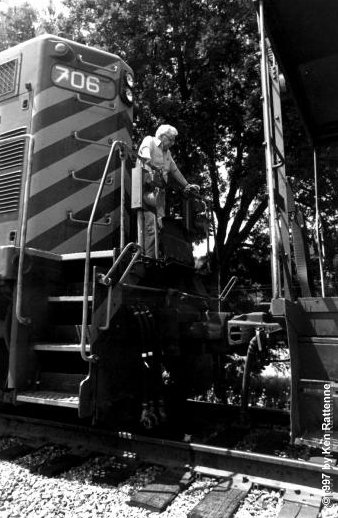
Photo by Ken Rattenne WP GP7 706 couples to the O-WPX on 8/7/82 under the watchful eye of Engineer McClure. Aboard caboose 431 isthe O-WPX's "captain," Conductor W.F. Filbeck, who is on the radio with the dispatcher in Sacramento. |
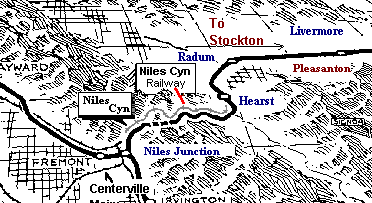 |
Western Pacific's line is shown in black, while the now-abandoned Southern Pacific line is grey. The Niles Canyon Railway now operates over this portion of the old SP line. |
